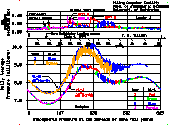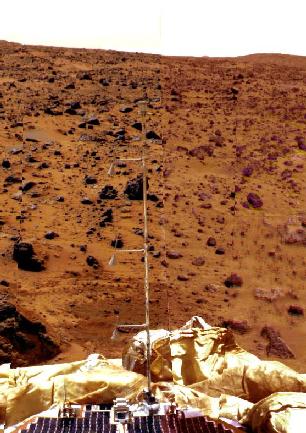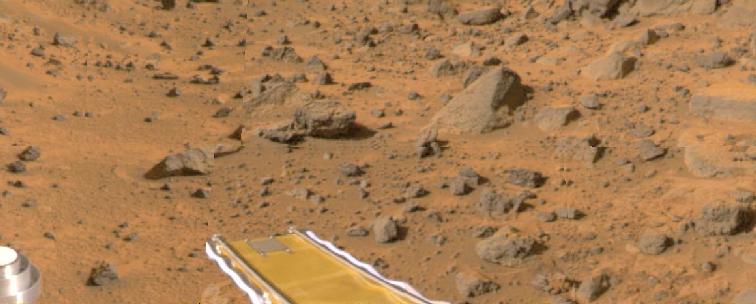![[Live from Earth and Mars]](http://www-k12.atmos.washington.edu/k12/graphics/xmars_map.gif.pagespeed.ic.Bwqa4QZhmw.png)
![[Live from Earth and Mars]](http://www-k12.atmos.washington.edu/k12/graphics/xmars_map.gif.pagespeed.ic.Bwqa4QZhmw.png)
Atmospheric temperatures from the surface of Mars!
Mars
Meteorological Data and Graphs: Pathfinder and Viking.
![]() Introduction; Mars features and Earth -- Mars comparisons
Introduction; Mars features and Earth -- Mars comparisons
The surface of Mars; Perspectives from the Viking and Pathfinder landers Imaging and Meteorological observational are similar to a child's, while the rover Sojourner's perspective is like a cats Meteorological highlights; as observed by the Viking Lander Meteorology Experiment.
 Atmospheric
Pressure; The Martian
Climate record is described by using the
Viking lander atmospheric pressure record to
provide insights into diurnal, synoptic, seasonal,
annual and inter--annual time scales, and synoptic
to global spatial scales. Theses provide the basis
for understanding the Pathfinder meteorological
observations.
Atmospheric
Pressure; The Martian
Climate record is described by using the
Viking lander atmospheric pressure record to
provide insights into diurnal, synoptic, seasonal,
annual and inter--annual time scales, and synoptic
to global spatial scales. Theses provide the basis
for understanding the Pathfinder meteorological
observations.
Atmospheric Temperature
A section on "Energy and Temperature" in the Atmospheric Surface Layer, ASL, of Earth and Mars is currently under development.
Educational modules developed for K-12
schools
Pathfinder Mission Operations & Science from the surface of
Mars
Summary project description.
These educational resources utilize our understanding of the portion of Earth's atmosphere in which we live, capitalize on prior investigations of Mars, and exploit Pathfinders investigations measurements, as well as those of future missions. A primary goal is to help students explore the similarity and differences between the weather of Mars and Earth, since these provide exciting and important science concepts related to numerous other fields: they also provide an excellent basis for understanding the methodology and nature of scientific inquiries.
Mars, of all the planets in our solar system, is the most similar to Earth. These materials describe some of the general characteristics of Mars, concentrating on those important to Martian meteorology, especially observations of atmospheric temperature . Although its diameter is only 53% that of Earth, it has dramatic geological features ranging from a 3000 mile (~ 5,000 km) long canyon system and Martian volcanos, that rise 29 km, more than 90,000 feet, above the mean Martian surface. The axis about which Mars rotates, is inclined approximately 23.98° to its orbital plane, compared to Earth's 23.44°, its day, called a sol, is 24.66 hours, and its year is 669 sols. Currently it has a very thin, cold, mainly carbon dioxide, CO2, atmosphere about 1% as dense as Earth's, and some water-ice clouds but no liquid water . However, Viking interpretations of orbiter images very strongly suggest that it had running water earlier in its history.
![]()
Comparison of Earth and Mars (As of 05 Sept. 1997 this figure contains
the correct angle of inclination for Mars of 25.19°.
The previously incorrect value of 23.98° was taken from a NASA Web page.)
The Viking Lander observations, July 20, 1976 through Nov. 12, 1982, provide the foundation for this resource. These observations are the only source of in situ Martian meteorological data, and Pathfinder will land very near Viking Lander 1, VL1, which is at 22° N, 148° W, while VL2 is 48° N, 225° W. Additional Earth -- Mars comparative data and definitions may be found here.
Viking and Pathfinder perspectives of the surface of Mars are similar human perspectives, since the cameras are 1.3 and 1.0 meters above the surface respectively: the view from Pathfinders Sojourner rover cameras are that of a cat. Both imaging systems have stereo viewing and multiple filters to produce color images. Pathfinder IMP camera has 12 different filters, for mineralogy, magnetics and atmospheric dust and water vapor investigations. The Viking surroundings are described by Moore, Tillman and LeCompte, in The Viking Landers and the Surface of Mars . Viking Lander 1, the Thomas Mutch Memorial station, resides on the south west slope of the large Chryse basin. Its immediate surroundings include soft sand, hard soil, and rocks from a few cm in size to "Big Joe", roughly a meter above the soil. The soil is so soft under footpad 2 , (which contains the entry temperature sensor that continued to function throughout the mission), that the footpad buried "16 cm into a soillike material" as described in these exercises by Dr. Henry J. Moore. Footpad 3 barely made a dent in the soil, as shown by other images. The landscape varies widely with direction from VL1. VL2 is located on Utopia Planitia, where the terrain is uniformly covered with rocks. Future developments will will cover some of the terrain and geology aspects.
 This Pathfinder image illustrates the
nearby environment, such as the air bags, solar panels and terrain,
which affect the meteorology observations. The meteorology mast is
mounted on the end of the solar panel, to minimize the range of wind
directions from which air flows over lander components before reaching
the meteorology sensors. The air bags, which have not been fully
retracted, are at different temperatures than the Martian surface,
while a wider view shows that the surface roughness varies with wind
direction. Winds coming toward the lander from 120° either side
of the optimum wind direction will be less disturbed than winds from
the remaining 120°, where the flow is over the solar panels and
the rest of the lander. The solar panels absorb almost all of the
solar energy, converting about 20% to electricity. The remaining 80%
of the absorbed solar energy, heats the solar panels, which in turn,
heats the adjacent ground, and the atmosphere. The lander and the
Martian surface temperatures differ during both during daytime heating
and night time cooling. These effects cause the air temperature
measured by the meteorology sensors to differ from the temperature
that would be measured over the nearby surface, especially for
directions passing over the lander and even more for light winds.
This Pathfinder image illustrates the
nearby environment, such as the air bags, solar panels and terrain,
which affect the meteorology observations. The meteorology mast is
mounted on the end of the solar panel, to minimize the range of wind
directions from which air flows over lander components before reaching
the meteorology sensors. The air bags, which have not been fully
retracted, are at different temperatures than the Martian surface,
while a wider view shows that the surface roughness varies with wind
direction. Winds coming toward the lander from 120° either side
of the optimum wind direction will be less disturbed than winds from
the remaining 120°, where the flow is over the solar panels and
the rest of the lander. The solar panels absorb almost all of the
solar energy, converting about 20% to electricity. The remaining 80%
of the absorbed solar energy, heats the solar panels, which in turn,
heats the adjacent ground, and the atmosphere. The lander and the
Martian surface temperatures differ during both during daytime heating
and night time cooling. These effects cause the air temperature
measured by the meteorology sensors to differ from the temperature
that would be measured over the nearby surface, especially for
directions passing over the lander and even more for light winds.
(Images: J Maki, & others; Pathfinder IMP Team, NASA JPL)
On the Viking landers, similar atmospheric temperature measurement problems occurred even though the lander was painted white. Its power source was a Radio-Isotope Thermoelectric Generator, RTG, producing about 50 watts of electricity and 900 watts of heat from radioactive decay: this excess 900 watts heats the lander and the air. (RTG power sources dramatically simplify the design and reduce the cost of Mars Spacecraft, and allow us to conduct missions that are impossible with solar power. If Pathfinder had a RTG or even a RHU, Radioactive Heater Unit, it might have lasted far longer and been able to communicate with its lonely, wandering, Sojourner, for many more months.) Part of this heat was used to maintain the Viking landers interior warm, with temperatures in a range that would be comfortable for a space suited human, and ideal for the instruments. The rest was transferred to the air from the lander and from heat dissipating fins on the RTG. During very light wind conditions, air flowing over the lander was heated by as much as 10°C, causing errors in the measurements of atmospheric temperature. Due to the length of the boom and placement of the sensors, "Lander Interferrence" errors are minimum for the best two thirds of the wind directions. When the winds reach 10 meters/second (22 miles/hour), the errors also are small.
The image below, which is to the right of the image above, shows a gully indicating water erosion occurred directly in front of the rover ramp. The tilted, flat surface rocks, also imply that a very strong flow occurred here.
Please refer to one of the Pathfinder mirror sites for the latest Pathfinder information.
:

Atmospheric pressure for most of the Viking Mission superimposed on an
annual time line.
Sols after landing of Viking Lander 1
Beginning on sol 0.
Atmospheric temperatures are the featured Pathfinder meteorological observations and the temperatures encountered at the surface of Earth and Mars provide the primary basis for these developments. All prior surface based Mars atmospheric meteorological observations were obtained by the Viking Meteorology Experiment. The temperatures on the two landers, measured at 1.5 meters above the surface, range from + 1° F, ( -17.2° C) to -178° F (-107° C). However, the temperature of the surface at the winter polar caps drop to -225° F, (-143° C) while the warmest soil occasionally reaches +81° F (27° C) as estimated from Viking Orbiter Infrared Thermal Mapper.
Temperature, a daily experience of students, is featured in these developments due to the wide ranging applicability of the underlying science concepts. It is a particularly rewarding study topic, since it is relatively easy to measure, and students can compare their observations with each other, with past and present Earth and Mars observations, and with the results from Pathfinder on a day by day basis. Although atmospheric temperature is determined by many factors, the daily cycles of solar heating is easy to grasp by first graders. Our goal, with our collaborating teachers, is for primary students to understand not only the solar heating, but Infrared cooling, since the balance between radiation, conduction and convection, controls temperature on scales ranging from those of insects to humans to planets. Deeper investigations of topics, such as cloudiness, wind chill, insulation, soil properties, evaporation and condensation, expands students knowledge and opens the door to the study of climate change and a multitude of topics.
Winds are only considered briefly here: better and expanded descriptions will be covered in future developments. Winds during summer, Pathfinders landing season, were light at both Viking sites, ranging from zero to about 22 miles per hour (0 to 10 meters/second). ( My forecast for the pathfinder site is that they will be similar to or weaker than at VL1.) During fall and winter, as the fronts become stronger, the winds increase. At VL-2, they reached 50 miles/hour ( 23 meters/sec). It is estimated that VL1 winds reached much higher speeds around the sol 1,720 time frame. The speed can not be calculated as the wind sensors had partial failures but the removal of piles of sand placed by the soil sampler, suggests winds of greater than 60 MPH, (28 m/s). An important thing to remember is that the force of the wind is lower on Mars by about a factor of 10, compared to Earth due to its lower density. The nature of the "fronts" and dust storm features are best observed by examining the data in more detail. They will be described in future developments, to the extent resources become available.
Atmospheric dust causes daily pressure variations proportional to the dust amount; the magnitude of the daily variation can increase rapidly, but decreases slowly as the dust falls out of the atmosphere if its a deep, great dust storm. "Great" dust storms, such as the 1977 A and 1977 B storm, produce large increases in the daily variation which slowly decrease over many tens of sols. The global oscillations observed produce daily pressure variation increases and decreases over a few sols, and are indicated by the label "Transient Normal Modes." They seem to repeat at the same time each year due to the atmospheric temperature causing the resonance to drift through the diurnal period at the same time of year. Finally, the frontal activity is indicated by marked increases in this variability indicator, but the sol to sol values change significantly as the storms pass by. Note that the frontal variability during the winter of year 2, (green), and year 3, (blue), is markedly different than the smoothly decaying year 1, 1977 B dust storm. During these dust storms, the maximum daytime temperature decreases and the minimum, nighttime temperature increases: the effect is very similar to that of clouds on Earth and details will be presented in future enhancements. The effect of the Martian dust storms provided some of the impetus for the study of the "Nuclear Winter" concept in the TTAPS paper, authored by Turco, Toon, Ackerman, Pollack and Sagan: the latter two were Viking Science Team members.
A suite of exercises comparing the pressure, temperature and wind, during equivalent dust storm seasons during the first and second years, are planned for future exercise and material development.
An important goal is to keep Pathfinder operational through this season, post sol 212, (6 Feb. 1998), to determine whether great dust storms occur this year and if so, their strength, timing and other characteristics, such as initiation and possible trigger mechanisms, Tillman 1988, Zurek 1988. . Unfortunately, this did not happen.
Unless otherwise specified, Mars images are courtesy of NASA JPL or
Hubble.
The assistance of George LeCompte and Neal Johnson gratefully is
acknowledged.
